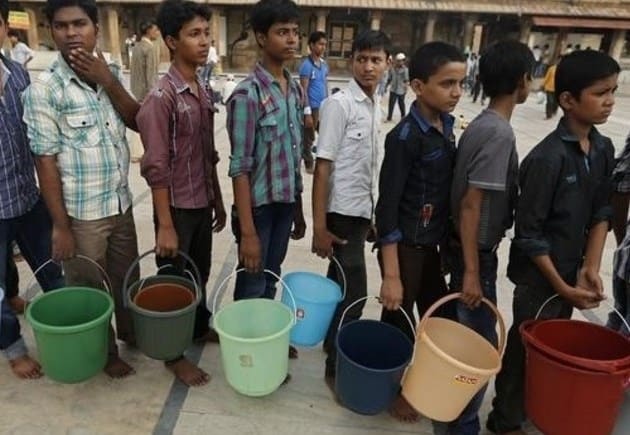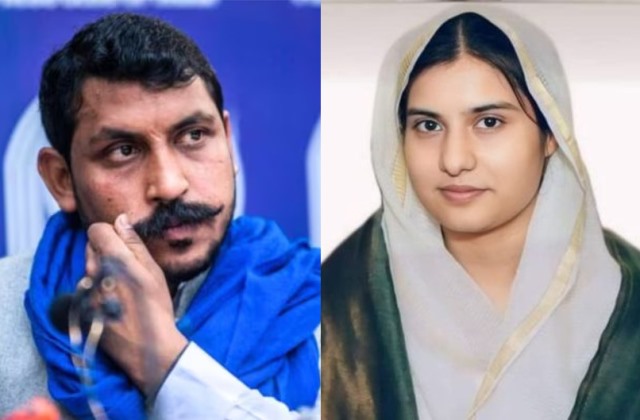
Water – India Has A Hole In The Bucket!
Decades of neglect in rightly managing our fresh water resources, which in any case are quite tight considering its multipurpose uses, including supporting agricultural operation and quenching the thirst of over 1.3 billion, is now spelling untold miseries to millions across the country as it poses a threat to India’s ambitious growth targets.
Drought having gripped 43 per cent of the country and the monsoon deficit still at 17 per cent, thanks to some strong rains in the north but masking the persistent rains shortfall in the south, a large percentage of population is having a nightmarish existence. The government machinery as usual is found wanting in providing relief to people living in parched parts of our earth.
The principal culprit for the current state of affairs is unarguably the indiscriminate way we have been extracting groundwater and in the process earning the dubious distinction of being the world’s most aggressive miner of the precious resource. To put it in perspective, India’s groundwater extraction exceeds the combined tally of the world’s second and third largest users, namely, China and the US.
India is home to 17 per cent of the world population but has to make do with 4 per cent of the earth’s fresh water. China, which houses more than a fifth of the world population, has only 7 per cent of its fresh water. It, however, faces the perennial challenge of meeting minimum water requirements of North China plains where close to 42 per cent of the country’s population lives but holds only 8 per cent of its water resource.
Like China, the US owns 7 per cent of the world fresh water. But it has the advantage of being home to 4.3 per cent of world population. No wonder, the US indulges in the luxury of leaving an average water footprint that is double the global average. No matter that the country owns the world’s largest fresh water lake system in the world in its Great Lakes and the mighty Mississippi river, the importance of conservation and efficiency in use for future security in water supply is not lost on the US Administration. Incidentally, water is one of the seven science missions of the US Geological Survey.
We in India are sourcing over 70 per cent of our water requirements from below the surface drilling aquifers at progressively greater depths without leaving adequate time for natural replenishment. Mihir Shah, a former member of the defunct Planning Commission says: “Over the last four decades, around 84 per cent addition to the irrigated area came from groundwater. Most of this was from deep drilling of tubewells or borewells, which are the single largest source of irrigation as also drinking water, in both rural and urban India.”
Going deeper and deeper the aquifers for water extraction has meant our mining the resource in a growing number of places where the water comes with unacceptable levels of fluoride, arsenic and iron. Use of such water leaves people with serious bone deformities and lung and bladder cancer. Extraction of groundwater at levels where the resource found is polluted and its use results in the government spending millions for treatment of the diseased.
A major failing of our hydrological planning is not conserving enough water for offseason that is beyond the monsoon months. Even after we have built a few thousand large and small dams in different parts of the country, our per capita storage of 215 cubic metre (CM) compares unfavourably with 1,111 CM in China and 1,964 CM in the US. In water conservation, Russia’s per capita tally at 6,103 is way ahead of other countries.
Prime Minister Narendra Modi in his first monthly radio broadcast programme ‘Mann ki Bat’ after winning the elections reminded the water hungry listeners that “only 8 per cent of all rain water in India is conserved… It’s now time to solve the problem” by giving a push to greater grassroots water conservation efforts. What the PM has proposed now should have actually been implemented in past years with great force. Maybe the administration is awakened to the situation now because of the spectre of millions of people in drought affected parts of the country are driven to the edge and food production is to take a hammering. The latter is because more than half of the country’s arable land is rain-fed. India receives around 70 per cent of rains during the southwest monsoon beginning in June and petering out in mid-September.
What India must be geared to is the weakening monsoon in South Asia caused by climate change. Rains in the region were below average for five years in a row, with 2015 being the worst at 86 per cent. Think tank Niti Aayog says in a report that the country faces the harrowing prospect of 40 per cent of its people not having access to drinking water by 2030.
Furthermore, at least 21 cities, including the national capital will run out of groundwater in 2020. Hospitals in southern Indian states finding piped water supply gone dry are getting it for the time being from local politicians owned fleets of water tankers at usurious rates. But this source of water may also run dry and too soon.
In Delhi, less than one fifth of homes have the luxury of piped water supply. In a growing number of places, whatever groundwater is extracted comes with chemicals and other contaminants. It is in the context of tightening water supply is to be seen Modi’s promise of delivering piped water to every home by 2024. As things are now, there is every chance of this post election victory promise remaining unfulfilled as his earlier commitment to create 10 million jobs every year.
Veena Srinivasan of Ashoka Trust for Research in Ecology and Environment will attribute the deteriorating water scene in the country to “multiple causes, both climate and anthropogenic… Of course, the drought itself is caused by a deficit in precipitation and climate change certainly has something to do with the changing precipitation patterns. But… we can’t absolve ourselves from the crisis that we ourselves have precipitated with mismanagement, and specifically by over-extracting groundwater.” She thinks Green Revolution gave licence to millions of farmers to use groundwater without limits to “rise out of poverty.”
The fact is when in the beginning of the sixties India was plunged in a major food crisis, Norman Borlaug and his prescription for breakthrough in rice and wheat productivity not only made the country self-reliant in food but also generated surplus for exports. Remember when Green Revolution was launched, the awareness of water conservation was hardly there in India or for that matter anywhere else. In subsequent times, however, the administration in Punjab and Haryana should have discouraged water guzzling rice cultivation in favour of less water using crops. In any case, the present crisis could have been avoided by the local government disallowing indiscriminate exploitation of underground water.
Farm and allied sector’s contribution to gross domestic product (GDP) has come down over the years to less than 15 per cent while it accounts for over 90 per cent of total water use. Again nearly 90 per cent of extracted groundwater is used in irrigation. But as Niti Aayog CEO Amitabh Kant says water use efficiency in our farm sector is among the lowest in the world. He says: “Our farmers use three to five times more water than Chinese, Israeli and American farmers for producing the same crop.” The remedy prescribes by Kant is to motivate farmers to “adopt cropping patterns based on agro-climatic zoning” to economise on water use. At the same time, radical modification of “subsidies and minimum support price” is needed to “disincentivise farmers from growing water intensive crops.”
Om Prakash Dhanuka, a former president of Indian Sugar Mills Association and a Bihar based producer of sugar, sees no justification of growing highly water-intensive sugarcane in parts of the country, which are highly drought prone and perennially short of water. Because of our surplus sugar production, we are desperate to export large quantities to wriggle out of price falls in the domestic market. But we must remember that when we are exporting sugar or rice, we are also exporting water.
Dhanuka, however, says: “It’s not all despair. For example, at Hiware Bazar village in Maharashtra, the community of farmers is opting out of sugarcane and cotton growing for less water-intensive crops. Farmers are not allowing any more digging of borewells and they are practising water management on scientific lines. We are also seeing similar farmer initiative in Andhra Pradesh and Telengana. Water management will have to be a nationwide movement in which the government, scientists and farmer community must participate wholeheartedly.”



